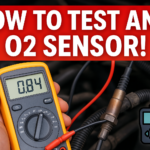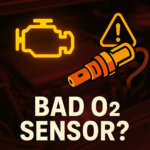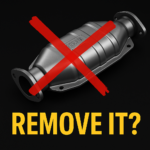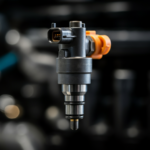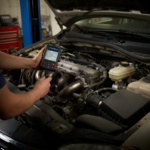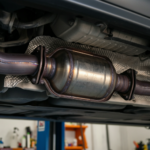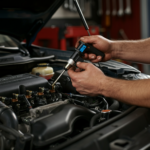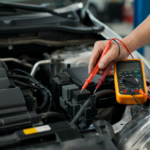Gasoline is the lifeblood of your car’s engine, fueling every ignition, acceleration, and smooth ride. But what happens when this vital fuel source becomes contaminated or degraded? Experiencing symptoms of bad gasoline in your car can lead to diminished performance, costly repairs, or even complete engine failure.
This blog post will guide you through identifying the signs of bad gasoline in a car, understanding why it happens, and learning how to fix it. Whether you’re a driver, car owner, DIYer, or mechanic, this guide can help ensure your car runs as smoothly as possible.
What Is Bad Gasoline and Why Does It Happen?
Bad gasoline refers to fuel that has become contaminated or degraded, losing its quality and effectiveness. Contamination occurs due to water, impurities, or debris mixing with the gas. Degradation, on the other hand, happens when gas sits unused in your tank for an extended period, leading to the breakdown of chemical properties.
Common causes include:
- Water contamination during refueling at gas stations with compromised fuel tanks.
- Dirty or aging fuel tanks in your vehicle.
- Improper storage of gasoline over long periods.
- Mixing incompatible fuel types, resulting in poor combustion.
Understanding what causes bad gasoline is the first step in preventing it from damaging your vehicle.
How Do You Know If You Got Bad Gasoline?
Wondering how to tell if gas is bad? Here are common symptoms of bad gasoline in cars you should watch for immediately after refueling or during regular drives.
1. Difficulty Starting the Engine
Bad gasoline can hinder proper ignition, causing the car to crank without starting. This is often due to contaminated fuel failing to combust efficiently in the combustion chamber.
2. Engine Misfiring or Stalling
One symptom of bad gas is inconsistent fuel delivery to the engine, which can lead to frequent misfires or sudden stalling. Learn more about engine misfiring by reading this detailed guide.
3. Decreased Fuel Efficiency
If you notice you’re refilling your tank more frequently but covering fewer miles, bad gas could be the culprit. It compromises combustion efficiency, leading to wasted fuel.
4. Check Engine Light Activation
Contaminated gasoline can trigger the check engine light due to disrupted fuel system operations. While there are many possible reasons for the light to come on, bad fuel is a common one.
5. Engine Surging or Hesitation
Bad gas in a car causes fluctuating performance during acceleration, where the vehicle unexpectedly surges forward or hesitates.
6. Strange Noises Like Knocking
Ever wondered “what does bad gas sound like in a car?” Listen carefully for knocking, pinging, or rough idling—these are classic signs of bad gasoline affecting the ignition process.
Tip: Keep an ear out for unusual sounds and check for significant changes in car performance after refueling.
What Does Bad Gas Do to Your Car?
Bad gasoline can impact various parts of your vehicle’s fuel system and engine. Here’s a breakdown of what happens when you put bad gas in your car if left unchecked.
- Clogged Fuel Injectors: Debris and contaminants block fuel injectors, leading to uneven fuel delivery.
- Damaged Fuel Pump: Contaminated fuel strains the fuel pump, leading to overheating or malfunction.
- Corrosion in the Fuel Tank: Water contamination encourages rust and reduces the lifespan of your tank.
- Poor Ignition Timing: Low-quality gas disrupts combustion and ignition sequences, leading to inefficiencies.
How to Test for Bad Gas in Your Car
If you’re asking “how can you tell if gas is bad?” follow these diagnostic steps to confirm your suspicions before taking remedial action.
1. Check for Water Contamination
Fill a transparent container with gas from your tank. If water contamination exists, you’ll notice the gas separating into two layers.
2. Inspect for Color or Odor Changes
Gasoline naturally has a light, fresh odor and a yellowish hue. Contaminated gas often appears darker and smells sour or “off.”
3. Use an OBD-II Scanner
A scanner can analyze error codes to identify fuel-system-related issues caused by bad gasoline.
4. Test Your Fuel System
Conduct a pressure test on your fuel pump or check fuel filters for clogging. Learn more about common fuel system issues and solutions here.
How Do You Fix Bad Gasoline?
Now that you’re familiar with bad gasoline symptoms, let’s explore how to address them effectively and restore your engine’s health.
1. Drain the Fuel Tank
The best way to get rid of bad gasoline is by draining it entirely. Use a siphon pump or have a professional mechanic assist you.
2. Add a Fuel Stabilizer or Cleaner
Products like fuel stabilizers or system cleaners can mix with contaminated gas to improve combustion. However, this is a temporary solution and works best for minor contamination issues.
3. Replace the Fuel Filter
Bad gasoline may leave debris in the filter, severely affecting vehicle performance. Replacing the filter ensures unimpeded fuel flow.
4. Refill with High-Quality Fuel
After removing contaminated gasoline, refill the tank with high-quality fuel from a trusted gas station. Opting for premium-grade options helps maintain clean combustion.
Tips for Preventing Bad Gasoline Problems
Prevention is always better (and cheaper!) than repair. Follow these tips to ensure your gasoline’s quality and keep your car running efficiently.
- Choose a Reliable Gas Station: Avoid fueling at stations with questionable maintenance.
- Use a Fuel Stabilizer when storing your vehicle for extended periods.
- Maintain a Full Tank: Keep it at least a quarter full to reduce the risk of condensation inside the tank.
- Monitor Fuel Quality: Watch for symptoms of bad petrol and act quickly to troubleshoot before issues escalate.
Stay Alert to Avoid Fuel System Troubles
Bad gasoline symptoms in cars can be frustrating, but staying informed and proactive can prevent major engine issues. Pay attention to your car’s behavior after refueling, and act swiftly if you notice any of the signs of bad gas.
Should you suspect bad gasoline, don’t hesitate to test your fuel and perform necessary fixes. For more guidance on fuel issues like clogged fuel pumps, explore this comprehensive guide. And for a complete understanding of how gasoline powers your engine, check out this helpful resource.


